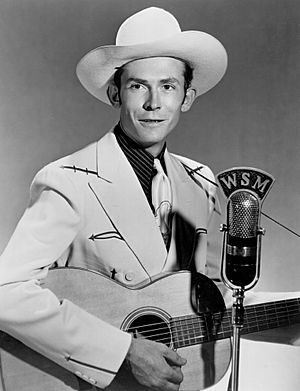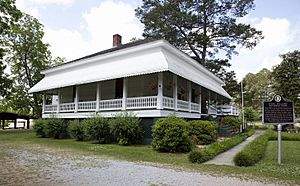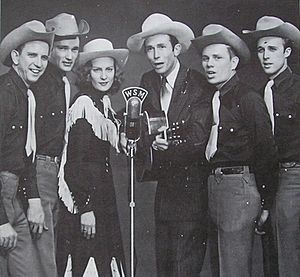Hank Williams facts for kids
Quick facts for kids
Hank Williams, Sr.
|
|
|---|---|

Williams in a WSM Radio publicity photo, 1951
|
|
| Background information | |
| Birth name | Hiram King Williams |
| Also known as | Luke the Drifter, The Hillbilly Shakespeare. |
| Born | September 17, 1923 Butler County, Alabama, United States |
| Died | January 1, 1953 (aged 29) Oak Hill, West Virginia, United States |
| Genres | Country, Western, gospel, blues, honky-tonk, folk |
| Occupation(s) | Singer-songwriter, musician |
| Instruments | Vocals, guitar |
| Years active | 1937–1953 |
| Labels | Sterling, MGM |
| Associated acts | Drifting Cowboys, Audrey Williams |
Hank Williams, Sr. (September 17, 1923 – January 1, 1953), born Hiram King Williams, was an American singer-songwriter and musician. He is regarded as one of the most significant and influential musicians of the 20th century. Williams recorded 55 singles that reached the top 10 of the Billboard Country & Western Best Sellers chart, five of which were released posthumously, and 12 of which reached No.1.
He was inducted into the Country Music Hall of Fame in 1961, the Songwriters Hall of Fame in 1970, the Rock and Roll Hall of Fame in 1987, the Native American Music Awards Hall of Fame in 1999, and gained a star on the Hollywood Walk of Fame.
Contents
Early life

Williams was born on September 17, 1923, in the rural community of Mount Olive in Butler County, Alabama. He was the third child of Jessie Lillybelle "Lillie" (née Skipper; 1898–1955) and Elonzo Huble "Lon" Williams (1891–1970). Hank had an elder sister, Irene, born on August 8, 1922. He also had a brother who died shortly after birth.
Williams's father worked as as an engineer for the railroads and frequently relocated for work, and as a result the family lived in several southern Alabama towns. In 1930, when Williams was seven years old, Elonzo began experiencing facial paralysis. After being evaluated at a Veterans Affairs clinic in Pensacola, Florida, doctors determined that he had a brain aneurysm, and Elonzo was sent to the VA Medical Center in Alexandria, Louisiana. He remained hospitalized for eight years and was mostly absent throughout Williams's childhood. From that point on, Lillie assumed responsibility for the family. She worked in a cannery and served as a night-shift nurse in the local hospital. Their first house burned down, and the family lost their possessions.
Williams got his first guitar when he was about eight years old. Gawky and shy, Williams attached himself to an old black man, Rufus "Tee-Tot" Payne, a street performer whom Williams followed around town. Payne gave Williams guitar lessons in exchange for money or meals prepared by Lillie. Williams later credited him as the provider of the only musical training he ever had.
Career
In July 1937, the Williams and McNeils opened a boarding house on South Perry Street in downtown Montgomery. It was at this time that Williams decided to change his name informally from Hiram to Hank. During the same year, he participated in a talent show at the Empire Theater and won the first prize of US$15 (equivalent to $300 in 2022) singing his first original song "WPA Blues". Williams wrote the lyrics and used the tune of Riley Puckett's "Dissatisfied".
He never learned to read music; instead he based his compositions in storytelling and personal experience. After school and on weekends, Williams sang and played his Silvertone guitar on the sidewalk in front of the WSFA radio studio. His recent win at the Empire Theater and the street performances caught the attention of WSFA producers who occasionally invited him to perform on air with Dad Crysel's band.
Williams' successful radio show fueled his entry into a music career, and he started his own band for show dates, the Drifting Cowboys, and dropped out of school to devote all his time to music.
The American entry into World War II in 1941 marked the beginning of hard times for Williams. While he was medically disqualified from military service after falling from a bull during a rodeo in Texas and suffering a back injury, his band members were all drafted to serve. Many of their replacements quit the band.
He started a job as a shipfitter's helper for the Alabama Drydock and Shipbuilding Company at Mobile in 1942, working there off and on for about a year and a half during the war. He also worked briefly at Kaiser Shipyards in Portland, Oregon. In 1943, Williams met Audrey Sheppard at a medicine show in Banks, Alabama. Sheppard told Williams that she wanted to help him regain his radio show, and that they should move to Montgomery and start a band. The couple were married in 1944 at a Texaco gas station in Andalusia, Alabama, by a justice of the peace. The marriage was technically invalid, since Sheppard's divorce from her previous husband did not comply with the legally required 60-day reconciliation period.
In 1945, back in Montgomery, Williams returned to WSFA radio. He attempted to expand his repertoire by writing original songs, and he published his first songbook, Original Songs of Hank Williams, containing "I'm Not Coming Home Anymore" and several more original songs, nine in all, including one not written by him, "A Tramp on the Street". With Williams beginning to be recognized as a songwriter, Sheppard became his manager and occasionally sang and substituted on guitar when a band member did not make the show.
After recording "Never Again" and "Honky Tonkin'" with Sterling Records, he signed a contract with MGM Records. He released the hit single "Move It On Over" in 1947 and joined the Louisiana Hayride radio program. The next year he released a cover of "Lovesick Blues", which quickly reached number one on Billboard's Top Country & Western singles chart and propelled him to stardom on the Grand Ole Opry.
As with many musical pioneers, Williams did not set out to create a new kind of music. He simply wanted to make music that his listeners would enjoy, that he would also enjoy making for them.
Some of Williams's songs are "Your Cheatin' Heart", "Hey Good Lookin'", "Jambalaya", and "Cold, Cold Heart". The songs were easy to remember, and many fans sang along when they heard them. Other singers began to include Hank Williams songs in their repertoires. Williams made recordings, performed on radio and early television, and also made live appearances.
Death
Williams suffered from heart failure and died suddenly in the back seat of a car near Oak Hill, West Virginia, en route to a concert in Canton, Ohio, on New Year's Day 1953. He was 29 at the time of his death.
Legacy
Williams' songs are still popular, and sung by many musicians. Many artists of the 1950s and 1960s, including Elvis Presley, the Beatles, Bob Dylan, George Jones, Tammy Wynette, Jerry Lee Lewis, Merle Haggard, Gene Vincent, and Ricky Nelson and Conway Twitty were influenced by Williams.
Personal life
Hank's personal life was sometimes complicated. He married Audrey Sheppard in 1944. She and Hank had a son together, Hank Williams Jr., who also became a famous country singer. The couple divorced in 1952.
In 1952, Hank married Billie Jean Jones Eshliman. Their marriage was short.
After Hank's death, it was discovered that he had a daughter named Jett Williams, who was born just a few days after he passed away. Jett also became a country singer.
Interesting facts about Hank Williams
- Williams was named after Hiram I of Tyre (one of the three founders of the Masons, according to Masonic legend), but his name was misspelled as "Hiriam" on his birth certificate.
- As a child, he was nicknamed "Harm" by his family and "Herky" or "Poots" by his friends.
- Hank Williams was of English-American ancestry.
- Williams learned to play basic guitar chords from his aunt and listened to music that was played at dances and in area churches.
- Williams is known as "the Father of Country and Western Music", because his songs were some of the first to come from that genre.
- Williams's final single, released in November 1952 while he was still alive, was titled "I'll Never Get Out of This World Alive".
- Alabama governor Gordon Persons officially proclaimed September 21 "Hank Williams Day". The first celebration, in 1954, featured the unveiling of a monument at the Cramton Bowl that was later placed at the gravesite of Williams.
- In 2004, Rolling Stone ranked him number 74 on its list of the 100 Greatest Artists of All Time.
- In 2005, the BBC documentary series Arena featured an episode on Williams.
- Williams was portrayed by English actor Tom Hiddleston in the 2016 biopic I Saw the Light, based on Colin Escott's 1994 book Hank Williams: The Biography.
- In 2010, Williams's 1949 MGM number one hit, "Lovesick Blues", was inducted into the Recording Academy Grammy Hall of Fame.
- The same year, Hank Williams: The Complete Mother's Best Recordings ...Plus! was honored with a Grammy nomination for Best Historical Album.
- In 1999, Williams was inducted into the Native American Music Hall of Fame.
Awards
| Year | Award | Awards | Notes | References |
|---|---|---|---|---|
| 1987 | Grammy Lifetime Achievement Award | 29th Annual Grammy Awards | Posthumously | |
| 1989 | Grammy for Best Country Vocal Collaboration ("There's a Tear in My Beer") | Grammy | with Hank Williams Jr. | |
| 1989 | Music Video of the Year ("There's a Tear in My Beer") | CMA | with Hank Williams Jr. | |
| 1989 | Vocal Event of the Year ("There's a Tear in My Beer") | CMA | with Hank Williams Jr. | |
| 1990 | Video of the Year ("There's a Tear in My Beer") | Academy of Country Music | with Hank Williams Jr. | |
| 1990 | Vocal Collaboration of the Year ("There's a Tear in My Beer") | TNN/Music City News | with Hank Williams Jr. | |
| 1990 | Video of the Year ("There's a Tear in My Beer") | TNN/Music City News | with Hank Williams Jr. | |
| 2010 | Special Awards and Citation for his pivotal role in transforming country music | The Pulitzer Prize | Posthumously |
Images for kids
-
Entrance marker of the Oakwood Annex Cemetery in Montgomery, Alabama
-
Hank Williams's star at 6400 Hollywood Boulevard, on the Hollywood Walk of Fame
See also
 In Spanish: Hank Williams para niños
In Spanish: Hank Williams para niños






